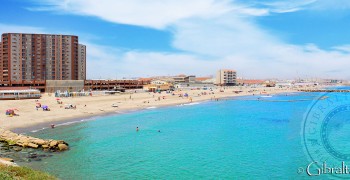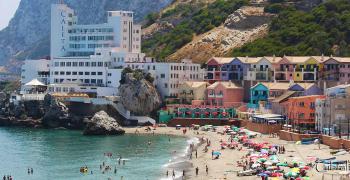Since ancient times history has revealed to us the incredible importance of the Rock’s strategic position and exceptional vantage point, when comparing it to the rest of the continent. Being surrounded by the Atlantic Ocean and the Mediterranean Sea, with full view of the Strait of Gibraltar, it’s little wonder that so many foreign conquests have been witnessed by this amazing Rock.
Recent history shows us incredible feats made by the British military in order to keep control of the Rock – the gateway to the Mediterranean. World War II is no exception. Having command of the western entrance to the Mediterranean, its modern cannons located at the top of the Rock made it extremely treacherous for enemy surface ships to pass between the Atlantic and the Mediterranean.
Your journey begins at Hay’s Level, marked by a powerful mural that honours Gibraltar’s role in the war.
Winston Churchill knew therefore, that if Gibraltar were to be taken, the British and their Allies would find it near impossible to counter any German or Italian moves in the Mediterranean. Not only this, but the British would also lose an integral harbor, which at the time served as a base for their ships carrying out other operations in the Atlantic. Control of the North Atlantic and Mediterranean territory now played a vital role in the war, making an attack on Gibraltar almost imminent.
France had already fallen in 1940, leaving Spain, the only neutral territory standing between German and Italian forces and Gibraltar. Not only was this an opportunity for Spain to possibly re-claim Gibraltar, but the Spanish dictator General Francisco Franco had recently come to power during the Spanish Civil War with aid from both Hitler and Mussolini.
And as you would guess it, the Germans were in fact planning that very move, code-named Operation Felix. After failing to persuade Franco to enter the war on their side, they later hoped he would agree to giving safe passage to a German army through Spain in order to attack Gibraltar.
Spain however was still weak and recovering from its own Civil War, making Franco extremely hesitant to now become involved in another such strenuous battle. Franco however, not wanting to say no to his former benefactors, candidly made exorbitant demands on the Fascist dictators in exchange for Spain’s participation which they simply could not meet. As a result of this, Operation Felix was never carried out.
The British at the time however, were in no position at all to know Franco’s motives or for that matter how long Hitler would tolerate being led on. Winston Churchill and the British military leaders believed the answer to keeping control of Gibraltar was to construct within the Rock a massive network of tunnels. Basically, to build a fortress inside a fortress, or a city within a city.
Hidden deep inside the limestone heart of Gibraltar lies a remarkable world carved by courage and necessity.
Besides the amazing Great Siege Tunnels dug back in the 1700’s, newer tunneling had already been invoked before World War II had begun, by the rise of the Nazis in Germany and the outbreak of the Spanish Civil War. The start of World War II however would see the interior of the Rock changed forever.
Churchill’s new plan gave way to the most intensive tunneling ever carried out in Gibraltar’s history, leaving the Rock with an entire tunnel network amounting to approximately 34 miles (52 kilometres) in length. That may not sound like much, but when you realise that Gibraltar is made up of only 6.8 km² — its staggering!
At the start of the war, the civilian population was evacuated from the Rock. As the number of Garrison was increased, so too was the need for more protected storage area, supplies and siege accommodation. The expanded troops would require food, equipment and ammunition, and somewhere safe to store it all – never mind where to sleep and bath! The task at hand was not an easy one.
A massive intricate tunnel system built deep inside the Rock would meet these needs, protecting the soldiers and equipment from Luftwaffe bombing air raids, as well as attacks from land and sea. The hidden fortress would comprise of a series of complex tunnels and passages, all named after streets of English towns, so British troops could find their way around without getting lost. Some names included Peterborough, Maida Vale, Durham, and Doncaster.
To allow the military full control and ensure the safety of its people, Gibraltar’s civilian population was evacuated.
Four different companies specialising in tunneling from the Royal Engineers and the Canadian Army were hired for the incredible task that lay ahead. They would have to contend with serious dirt and dust from their excavations, working at times for months on end, often not seeing the light of day for very long periods at a time. Not only this, but during the war, Gibraltar’s water supply was heavily restricted, limiting the workers opportunity to wash off the heavy dirt and grime.
A pair of tunnels, the Great North Road and Fosse Way, were burrowed out, running almost the entire length of the Rock. These two main tunnels would interconnect with all the rest of the tunnels, allowing soldiers to move about freely within the Rock, in all directions, without been seeing from the enemy outside.
It’s interesting to note that most of the debris extracted from the tunnels was put into use by extending the airfield runway out into Gibraltar Bay. This actually played a significant role during the Allied invasion of North Africa in 1942, as the extended runway could now cater for larger aircraft, required for such an operation.
The intricate tunnel system connected the new Main Base Area established in the south eastern part of Gibraltar, protected behind the Rock from the potentially hostile Spanish mainland, with established military bases on the west side of the Rock. In fact, by the end, whether it be St Michael’s Cave (being used at the time as a backup hospital) or the Great Siege Tunnels on the Rock’s northern face, almost all parts of the Rock were accessible one way or another via this incredible underground city.
Interesting Fact
The World War II Tunnels are also home to one of Gibraltar’s most secret places. So secret, that it was not rediscovered until as recently as 1997. Built for Operation Tracer, there lies within the tunnels a Stay Behind Cave, where six men would remain behind hidden within the Rock if it had fallen to Germany. Their mission would be to report movements of enemy vessels back to the United Kingdom.
Besides the astronomical length of the new tunnel system, enormous bunker facilities had to be large enough to house a power generating station, a hospital ward, a water desalination plant, a telephone exchange, frozen food storage, a bakery, ammunition magazines, toilets and showers, a workshop to repair damaged vehicles and passageways, not to mention accommodation facilities sufficient to cater for 16,000 soldiers for the duration of up to 16 months if under siege! Wow!
The Tunnels: Gibraltar’s WWII Experience
A Fortress Beneath the Rock
Hidden deep inside the limestone heart of Gibraltar lies a remarkable world carved by courage and necessity. The Tunnels: Gibraltar’s WWII Experience takes you through this secret underground fortress — a place where engineers, soldiers, and civilians worked together to defend one of the most strategic outposts of the war. Step inside the echoing passages and discover the stories that helped shape Gibraltar’s history.
When World War II reached Europe’s doorstep, Gibraltar transformed from a quiet garrison into a fortress of global importance. Beneath its rugged cliffs, thousands of men toiled day and night, creating a hidden city capable of sheltering and sustaining a full military garrison through siege or attack. These tunnels stored ammunition and food, maintained vital equipment, and served as lookout posts keeping watch across the Strait and beyond to neutral Spain. What remains today is a lasting monument to Gibraltar’s resilience, ingenuity, and unbreakable spirit.
The Entrance and Hay’s Level
Your journey begins at Hay’s Level, marked by a powerful mural that honours Gibraltar’s role in the war. The artwork celebrates both the Rock’s natural strength and the courage of those who served within it.
The level is named after Lieutenant Colonel Robert Alistair Hay, Commander of the Royal Engineers between 1940 and 1944. Under his direction, Gibraltar’s defences were transformed. He oversaw the expansion of the tunnels and the reinforcement of the Rock’s fortifications, turning Gibraltar into one of the most secure positions in the world.
Before 1940, only a small number of Royal Engineers and civilian workers handled the tunnelling. But with the arrival of Colonel C.E. Fordham and his specialised companies, everything changed. By the end of that year, nearly 900 men were working underground. In 1941, Canadian Royal Engineers joined the project, bringing advanced machinery and new techniques that drastically increased progress. Every metre of tunnel was planned for both strength and survival — with blast traps and pockets built at the entrances to deflect explosions and protect those inside.
One of the highlights of the experience is Spitfire Hall, an immense chamber that once hummed with wartime activity.
Spitfire Hall
One of the highlights of the experience is Spitfire Hall, an immense chamber that once hummed with wartime activity. During WWII it served as a Royal Electrical and Mechanical Engineers workshop and a Royal Army Ordnance Corps depot — the beating heart that kept Gibraltar’s vehicles and weapons in working order.
Today, the hall has been beautifully restored and now doubles as an atmospheric events venue. At its centre stands a full-scale replica of Spitfire P8394 “Gibraltar”, funded in 1940 through public donations amounting to more than £5,000 — a symbol of the community’s unity and pride.
The Supermarine Spitfire itself, first taking flight in 1938, became a legend of the skies thanks to its sleek design and mighty Rolls-Royce Merlin engine. Gibraltar’s location made it an essential base for Spitfire missions, including those supporting Operation Torch in North Africa. From here, Allied pilots secured air superiority and disrupted Axis supply lines across the Mediterranean.
The Tunneller’s Rest
After exploring, visitors can pause at The Tunneller’s Rest, a bar styled after a 1940s officers’ mess. With vintage décor and an authentic wartime ambience, it’s the perfect spot to unwind and reflect on the people who once called these caverns home.
Strategy Rooms and the WWII Timeline
The exhibition also guides visitors through the political and military backdrop of the war. Beginning with the 1919 Treaty of Versailles — whose harsh terms set the stage for conflict — the timeline traces the rise of fascism and Gibraltar’s critical role once war erupted.
Sitting at the crossroads of the Atlantic and Mediterranean, Gibraltar became a lifeline for the Allied forces. Inside the tunnels, hospitals, stores, and command posts operated day and night. Supplies, fuel, ammunition, and food passed through this gateway to sustain operations in North Africa, the Middle East, and beyond. The Rock wasn’t just a fortress — it was the hinge on which the war in the Mediterranean turned.
The Evacuation of Gibraltar’s Civilians
To allow the military full control and ensure the safety of its people, Gibraltar’s civilian population was evacuated to destinations as far-flung as the UK, Madeira, Jamaica, Northern Ireland, and Morocco. Life in exile was often difficult, marked by crowded lodgings and uncertainty, yet the community’s endurance became part of the Rock’s wartime legend. Repatriation began in 1944, though it wasn’t until 1951 that the last evacuees returned home.
Espionage and Secrets Beneath the Rock
During the war, Gibraltar was more than a military base — it was a nerve centre of intelligence and espionage. Double agents like the mysterious Queen of Hearts helped uncover Axis sabotage attempts both underwater and on land, while operatives such as David Scherr worked tirelessly to protect the base from infiltration.
Among the most fascinating stories revealed inside the tunnels is Operation Tracer — a secret plan to seal six men inside a hidden chamber within the Rock should Gibraltar fall to enemy hands. Their mission: observe enemy movements and relay intelligence, possibly for years, without ever leaving. Though the plan was never put into action, the concealed observation post was rediscovered in 1997, complete with radio equipment and living quarters, frozen in time.
The Sapper’s Suite pays tribute to the Royal Engineers — or Sappers
The Sapper’s Suite
The Sapper’s Suite pays tribute to the Royal Engineers — or “Sappers” — whose skill and endurance shaped Gibraltar’s underground defences. With the help of Canadian tunnelling units and civilian experts, they worked tirelessly in extreme conditions, carving more than 45 kilometres of tunnels through solid rock. The limestone they removed even extended Gibraltar’s airport runway by 80 percent, proving that nothing went to waste.
An original BSA M20 motorcycle displayed in this area stands as a reminder of the mobility and engineering precision that defined the wartime effort.
The Gunners Gallery
In the Gunners Gallery, restored weapons, uniforms, medals, and personal artefacts bring Gibraltar’s wartime defence to life. The exhibition honours the Gibraltar Defence Force, whose vigilance and skill protected the Rock throughout the conflict. An adjacent cinema room screens restored footage and oral histories, ensuring that these memories endure.
Victory Walk
The final section, Victory Walk, celebrates the Allied triumph in Europe on 8 May 1945. Lined with original photographs and audio recordings from VE Day, it invites visitors to share in the relief and joy that swept through Gibraltar and the world when peace finally returned.
From engineering marvels to tales of bravery and resilience, The Tunnels: Gibraltar’s WWII Experience offers more than a glimpse into the past — it’s a journey into the spirit that defined Gibraltar itself. Beneath the Rock lies a living monument to endurance, ingenuity, and the unbreakable will of those who stood guard over the gateway to the Mediterranean.
































































































